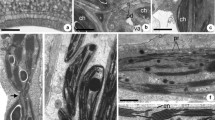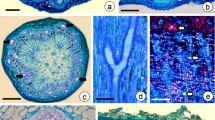Summary
Unusual bodies are of general occurrence in cultured protoplasts isolated from tomato “Ailsa Craig” fruit locule tissue. They are also common in the equivalent cultured plasmolysed tissue, but do not occur when the culture medium is non-plasmolysing. Similar bodies are of universal occurrence in cultured protoplast spontaneous fusion bodies from tobacco “Xanthi” leaves, but are not found when the cultured protoplasts are not initially fused. Bodies also occur in cultured protoplasts isolated from leaves of rye “Dominant”. They do not occur in cultured protoplasts from rose “Paul's Scarlet” cells.
These bodies have been studied by light and electron microscopy. Schiff and periodic acid—Schiff—phosphotungstic acid stains indicate the presence in them of cellulose, and this is also suggested by their fluorescence with calcofluor and their appearance in the electron microscope. Some of them fluoresce with aniline-blue. Some material within the bodies stains with phosphotungstic acid-chromic acid, suggesting that some of the contents of the bodies is plasmalemma-like. The bounding membrane is only partly stained with phosphotungstic acid-chromic acid. There is a general parallel between the composition of the wall regenerated by the protoplasts and the composition of these bodies, and between the timing and extent of their development and that of the regenerated wall. On the basis of these observations, these bodies are named “wall-bodies” and regarded as composed of similar materials to those making up the regenerated wall. The observations, especially of wall-body production by tobacco fusion bodies, strongly suggest a plasmalemma origin for the membranes of the vesicles in which these bodies arise.
Similar content being viewed by others
References
Brown, R. M., W. W. Franke, H. Kleinig, H. Falk, andP. Sitte, 1970: Scale formation in Chrysophycean algae. 1. Cellulosic and non-cellulosic components made by the golgi apparatus. J. Cell Biol.45, 246–271.
Burgess, J., E. N. Fleming, andF. Motoyoshi, 1973: Effect of poly-Lornithine on isolated tobacco mesophyll protoplasts: evidence against stimulated pinocystosis. Planta111, 199–208.
Cocking, E. C., andE. Pojnar, 1970: The uptake of viruses, cell wall regeneration and virus multiplication in isolated plant protoplasts. Acta Fac. Med. Un. Brun.37, 159–162.
Currier, H. B., 1957: Callose substance in plant cells. Amer. J. Bot.44, 478–488.
Davey, M. D., andE. C. Cocking, 1972: Uptake of bacteria by isolated higher plant protoplasts. Nature239, 455–456.
Evans, P. K., A. C. Keates, andE. C. Cocking, 1972: Isolation of protoplasts from cereal leaves. Planta104, 178–181.
Gamborg, O. L., andD. E. Eveleigh, 1968: Culture methods and detection of glucanases in suspension cultures of wheat and barley. Can. J. Biochem.46, 417–421.
Harrington, B., andK. Roper, 1968: Use of a fluorescent brightener (calcofluor) to demonstrate cellulose in cellular slime molds. Appl. Microbiol.16, 106–108.
Horobin, R. W., andA. Hague, 1971: Periodic acid-Schiff-phosphotungstic acid as an electron histochemical method for ultrathin sections. J. Microscop.94, 265–272.
Jensen, W. A., 1962: Botanical Histochemistry. San Francisco-London: W. H. Freeman and Co.
Kim, K. S., andJ. P. Fulton, 1973: Plant virus induced cell-wall overgrowth and associated membrane elaboration. J. Ultrastruct. Res.45, 328–342.
Nagata, T., andI. Takebe, 1970: Cell wall regeneration and cell division in isolated tobacco mesophyll protoplasts. Planta92, 301–308.
—, andT. Yamaki, 1973: Electron microscopy of isolated tobacco mesophyll protoplasts culturedin vitro. Z. Pflanzenphysiol.70, 452–459.
Nash, D. T., andM. E. Davies, 1972: Some aspects of growth and metabolism of “Paul's Scarlet” rose cell suspensions. J. exp. Bot.,23, 75–91.
Northcote, D. H., 1972: Chemistry of the plant cell wall. A. Rev. Pl. Physiol.23, 113–132.
Pate, J. S., andB. E. S. Gunning, 1972: Transfer Cells. A. Rev. Pl. Physiol.23, 173–196.
Pearce, R. S., 1972: The culture of isolated higher plant protoplasts. Ph. D. thesis, University of Nottingham.
—, andE. C. Cocking 1973: Behaviour in culture of isolated protoplasts from “Paul's Scarlet” rose suspension culture cells. Protoplasma77, 165–180.
Pojnar, E., J. H. M. Willison, andE. C. Cocking, 1967: Cell-wall regeneration by isolated tomato-fruit protoplasts. Protoplasma64, 460–480.
Reynolds, E. S., 1963: The use of lead citrate at high pH as an electron-opaque stain in electron microscopy. J. Cell Biol.17, 208–212.
Roland, J.-C., C. A. Lembi, andD. J. Morré, 1972: Phosphotungstic acid—chromic acid as a selective electron-dense stain for plasma membranes of plant cells. Stain Technol.47, 195–200.
Takebe, I., G. Labib, andG. Melchers, 1971: Regeneration of whole plants from isolated mesophyll protoplasts of tobacco. Naturwissenschaften58, 318–320.
Ulrich, J. M., andG. MacKinney, 1969: Callus cultures of tomato mutants. I. Nutritional requirements. Physiol. Plant.22, 1282–1287.
Willison, J. H. M., 1973: Fine structural changes occurring during the culture of isolated tomato-fruit protoplasts. In: Colloques Int. C.N.R.S. No.212, 215–241.
—, andE. C. Cocking, 1972: The production of microfibrils at the surface of isolated tomato-fruit protoplasts. Protoplasma75, 397–403.
—,B. Grout, andE. C. Cocking, 1972: A mechanism for the pinocytosis of latex spheres by tomato-fruit protoplasts. J. Bioenergetics2, 371–382.
Withers, L. A., andE. C. Cocking, 1972: Fine structural studies on spontaneous and induced fusion of higher plant protoplasts. J. Cell Sci.11, 59–76.
—, 1973: Plant protoplast fusion: methods and mechanisms. In: Colloques Int. C.N.R.S. No.212, 517–526.
Author information
Authors and Affiliations
Rights and permissions
About this article
Cite this article
Pearce, R.S., Withers, L.A. & Willison, J.H.M. Bodies of wall-like material (“wall-bodies”) produced intracellularly by cultured isolated protoplasts and plasmolysed cells of higher plants. Protoplasma 82, 223–236 (1974). https://doi.org/10.1007/BF01276309
Received:
Issue Date:
DOI: https://doi.org/10.1007/BF01276309




